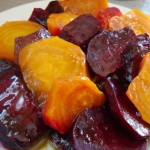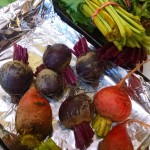This Meatless Monday, we have a beet recipe that takes it up a notch with mustard vinaigrette. We also have growing, storage and prep tips from Vermont Fresh: A Fruit and Vegetable Handbook.
This recipe was created for us by Karen Ranz, a volunteer testing and tasting recipes from Vermont Fresh. Thank you, Karen!
Meatless Monday Recipe: Roasted Beets with Mustard Vinaigrette
4 Servings
Ingredients:
- 1 lb fresh beets
- ¼ cup olive or walnut oil
- 1 Tbsp Wine or sherry vinegar
- 1-2 tsp prepared mustard
- ½ tsp Sugar
- ¼ tsp salt
Instructions:
- Cut the beets from their tops leaving an inch or more of stems attached.
- Roast in a 325 degree oven for 30 minutes to 1 hour depending on the size, until a knife tip slips in easily.
- Once cool enough to handle, peel with a sharp knife.
- Slice onto a serving plate and dress with a vinaigrette of the remaining ingredients shaken in a jar with a tight-fitting lid.
- Save the beet greens for cooking too!
Background
Grown now for thousands of years, beets are a truly old-fashioned vegetable. The wild ancestor of the beet we eat today is native to the Mediterranean region, where it still grows today. The Greeks and Romans used beets primarily for their leaves, however, and it wasn’t until the Middle Ages that the red roots of the plant became popular. Like many vegetables, beets were selectively bred to become the crop we know today. While the majority of beets are strikingly red in color (particularly when cut), golden and candy-striped varieties are popular as well. The beets that we eat are closely related to sugar beets, which are grown in extensive quantities in America for the production of sugar. Recently, the pigment producing compounds in beets have been found to help fight against heart disease and cancer, particularly colon cancer.
- Photo courtesy of Karen Ranz.
- Photo courtesy of Karen Ranz.
Growing Tips
Beets are hardy roots that actually thrive in cooler weather. Seeds can be sown directly into the soil in early spring or started inside and transplanted later. If transplanting, take care not to disturb the roots. Either way, beets will probably need to be thinned as they begin to grow—each seed cluster can produce more than one plant, and the roots need room to develop. Beet greens can be harvested as the roots grow but several leaves do need to be left intact for the plant to continue growing steadily. Beets grow best in loose soils with plenty of water and nutrients. Compacted soil will make it harder for the plants to grow, resulting in tougher, smaller roots. For a steady supply of beets, try sowing seeds every 3 or 4 weeks until midsummer. Light frosts will not damage beets, but they should be harvested before regular heavy frosts set in.
Storage
For long-term storage, beets are often pickled and canned. For a more short-term approach, store in your refrigerator (with 2-3 inches of stem attached) for about 3 weeks. Cooked beets can be frozen, but raw beets freeze poorly. You can also try storing beets in a root cellar or cool (but not freezing) garage. Submerged in a bucket of sand, they will keep for months.
Nutritional Benefits
Beets are high in sugar, making them often very sweet, but that does not make them unhealthy. Beets are very rich in nutrients such as Vitamin C, magnesium, and potassium. Furthermore, they are packed with phytochemicals and antioxidants and are thoughts to contribute to a healthy heart.
Preparation
Beet juice can stain, so take care when preparing beets, which can be eaten raw, boiled, steamed, roasted, or pickled. If boiling, leave the skins on until the roots are fully cooked, when you can rub off the outer layer. It is otherwise advisable to peel beets, especially if they are older and have tougher skins.
To receive more recipes and tips on your favorite fruits and vegetables, download Vermont Fresh: A Fruit and Vegetable Handbook.
Vermont Foodbank fresh food initiatives would not be possible without your support. Please consider giving to the Vermont Foodbank today!




